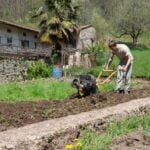Introduction
Gardening is a creative and rewarding hobby that allows you to bring the beauty of nature into your home. Growing a vegetable garden brings great satisfaction in producing your own fresh, nutritiously-rich food while also helping you reduce your overall grocery bill. When you water your vegetable garden correctly, it can provide the perfect environment for healthy plant growth.
Water is essential for any type of plant life, and vegetables are no exception. Without adequate moisture, plants will wilt and suffer; without proper amounts of water, this wilting and suffering can become permanent damage that reduces yields or completely kills the plants. With so much riding on watering correctly, it pays to understand how to properly keep vegetables hydrated as they grow.
The optimal source of water for a vegetable garden is gentle rainwater. When rainwater isn’t available or sufficient, irrigation must be used to make up the difference between what nature provides and what the vegetables need to thrive. Different types of irrigation systems include portable hoses or sprinklers, soaker hoses alongside raised beds, or an efficient drip system that directly targets multiple plants at once with slow drips over extended periods of time.
In order to ensure proper watering each day (or as needed), timing plays an important role in successful gardening strategies since over-watering can quickly lead to excess weeds and other problems. Depending on the size of your garden as well as climate conditions such as temperature, humidity levels, sunlight exposure and soil type / texture – all these factors combined should help determine how often to water during summer months when precipitation alone may not be enough for optimal growth potential.
Planning
The location of a vegetable garden will be determined by the amount of sunlight it receives with six to eight hours being ideal for most vegetables. As for space, it is important to consider how much land one has available to work with and what type of vegetables they aim to grow as some vegetables require more room than others. It can be helpful to make an estimating map prior to planting anything in order to determine exactly how much space each vegetable will need.
It is also essential to take into account the specific requirements that each type of vegetable requires as watering needs may vary among different types. If you choose vegetables that thrive in similar conditions, they can usually share the same set of irrigation requirements. Prior to planting, check your soil’s water capacity and make sure you have enough water supply (through a hose or well) to adequately irrigate everything that you choose to plant. Additionally, consider if you will install an irrigation system such as soaker hoses or sprinklers as these can help save time and ensure even and consistent watering for each plant throughout its growth season.
Prepping the Ground
Before you even think about adding water to your vegetable garden, you need to prep the ground for optimum growth. The soil should be well-drained and full of nutrients. Start by adding organic compost or other materials that can help improve your soil quality, such as manure or leaves. You can also purchase fertilizer and apply it at the appropriate time. Make sure you till the soil thoroughly so that it is loose enough for proper aeration and for roots to grow and expand. To test the soil fertility, take a sample to a laboratory and determine what exactly it needs before planting seeds or seedlings.
Planting
When it comes to planting a vegetable garden, the variety and timing of your seeds determine what will grow and how successful you will be in the harvest. Generally, warm season vegetables such as Tomatoes and Peppers should be planted outdoors no earlier than two weeks before the average last frost date for your area (this varies region to region so consult local weather forecast). Cold season vegetables such as Broccoli and Lettuce can usually be planted up to four weeks before the average last frost date. Once you have established when you will be planting them, make sure to purchase seed varieties that are suited to your growing area’s climate. It’s important to select a variety that matures at the same time or slightly ahead of what your mild-frost schedule dictates. As with any planting decision, consider soil nutrients available to each vegetable during their respective growth cycles and provide necessary supplements accordingly. Finally, when deciding on where best to locate each crop; sunshine is always important but keep in mind water access points (obviously more important once they begin needing regular watering).
Watering
When it comes to watering your vegetable garden, determining the right amount and frequency of water for proper maintenance is essential for optimum yields. Two factors will affect how much you need to water your vegetable garden: soil type and climate.
If you live in a colder area with little rainfall, you will need to water more often than someone living in a warmer, wetter climate with more frequent snow or spring thunderstorms. Generally, vegetables should be watered deeply (up to 18 inches deep) approximately one inch every week. However, the exact amount of water a plant needs can vary slightly depending on soil composition and weather conditions. If possible, use a moisture meter to measure the moisture levels in your soil first. This will help you determine how much and how often your plants need to be watered.
In addition, be careful not to overwater — it’s important that plants don’t become too saturated with water because this can cause root rot and other problems. Make sure to check the soil regularly as well; if it appears dry or is cracking along the surface, it’s time to give your vegetables a drink! Watering early in the morning gives plants time to draw up the moisture before temperatures heat up — this helps prevent evaporation and keeps them hydrated throughout the day. Tree-shaded areas may require less frequent watering than those located in sunny spots since trees keep some of sunlight off the ground and therefore reduce heat exposure on those areas.
Irrigation Strategies
When it comes to watering your vegetable garden, there are some basic irrigation strategies you can implement to save time and money. First, you should consider soil type when watering. Clay soils are very absorbent and therefore do not need to be watered as often, while sandy soils require more frequent watering because water drains quickly out of these types of soils. Second, plan strategically so that water is being applied at the appropriate rate with the goal of avoiding runoff and overwatering. If possible, raised beds or mounds can be used to ensure water moves where desired rather than accumulating on paths or tending toward areas where plants don’t need it. Additionally, selecting a type of sprinkler system based on specific crop requirements and characteristics such as foliage density and surface area can help conserve water by ensuring it only goes exactly where needed. If a sprinkler system isn’t an option for your garden due to budget restrictions or other circumstances, then consider investing in a hose-end timer or moisture sensor – just make sure you check the system regularly because inaccurate settings can lead to inadequate, excessive, or uneven application of water. Finally, when in doubt, let Mother Nature take care of things by leaving rain gauge out in the garden so that if no precipitation has fallen during the last three days you know it’s time to add more H2O!
Climate Adaptation
When creating a maintenance plan for your vegetable garden, it’s important to factor in changing seasonal conditions. The amount of water you need to give your garden will vary greatly depending on the season. For example, during the hot summer months, most gardens require significantly more watering than they do during milder temperatures or cold spells in winter months. To ensure your plants get the right amount of water, you should consider installing automatic irrigation systems that can be programmed differently for each season. Additionally, it’s important to note how long it typically takes for areas in your garden to dry out and adjust when necessary; if soil remains damp for too long its moisture may lead to disease or other problems with plant growth. Finally, check with local weather forecasts periodically throughout the growing season to assess if additional water is needed and make sure expectations are in line with predicted humidity and temperature changes. By making such simple considerations ahead of time, you will be able to keep your vegetable garden functioning at peak efficiency all year round!
Prevention
When it comes to watering vegetable gardens, prevention is key. When plants are too dry, they’re more vulnerable to pests and disease. To prevent water-related issues from occurring, you should do the following:
• Water your plants at the root level in the mornings. This will make sure that the plant is wet long enough for the water to absorb into the roots.
• Use mulch around your garden plants to help retain moisture in the soil and reduce weed growth.
• Install a drip irrigation system so that each plant gets its own source of water throughout the day and night. This also reduces wastage due to runoff and erosion as you don’t have to worry about how much water each plant needs as it is provided with exactly what it needs at set times during the day.
• Monitor your soil moisture levels regularly (especially during periods of drought) using a moisture probe if needed. This can help you adjust your watering schedule depending on how dry or moist your garden is.
• For crops that need more frequent watering, such as lettuce, use a soaker hose placed near their roots instead of spraying them directly with a hose end nozzle. The slow release of water helps ensure even coverage and prevents moisture from evaporating too quickly from shallow-rooted veggies like lettuce.
• In periods of extended drought, cover bare soil around plants with organic material such as hay or straw to prevent further evaporation losses from occurring.
Conclusion
Watering is a key factor in having a successful vegetable garden. Using the techniques outlined above will help ensure your vegetables are getting the moisture they need to grow and thrive. When you water your garden, be sure to make it for a specific purpose, such as to direct the water at the roots of plants or on container-grown plants which dry out quickly. Watering deeply will also encourage deeper root systems, which helps allow your plants to uptake more of the nutrients they need from the soil.
Finally, when watering your vegetable garden watch for signs that you are overwatering or underwatering; make adjustments as necessary. If your area has little rainfall, you may need to add irrigation systems. For instance, sprinklers placed around taller plants can help them reach their roots better or bring a hose or watering can closer to those in hard-to-reach places like containers and hanging baskets. Don’t forget to monitor your watering plan and make changes if needed throughout the growing season – it’s all part of having a healthy and productive vegetable garden.

If you’re looking to get into vegetable gardening, or are just looking for some tips on how to make your current garden better, then you’ve come to the right place! My name is Ethel and I have been gardening for years. In this blog, I’m going to share with you some of my best tips on how to create a successful vegetable garden.





